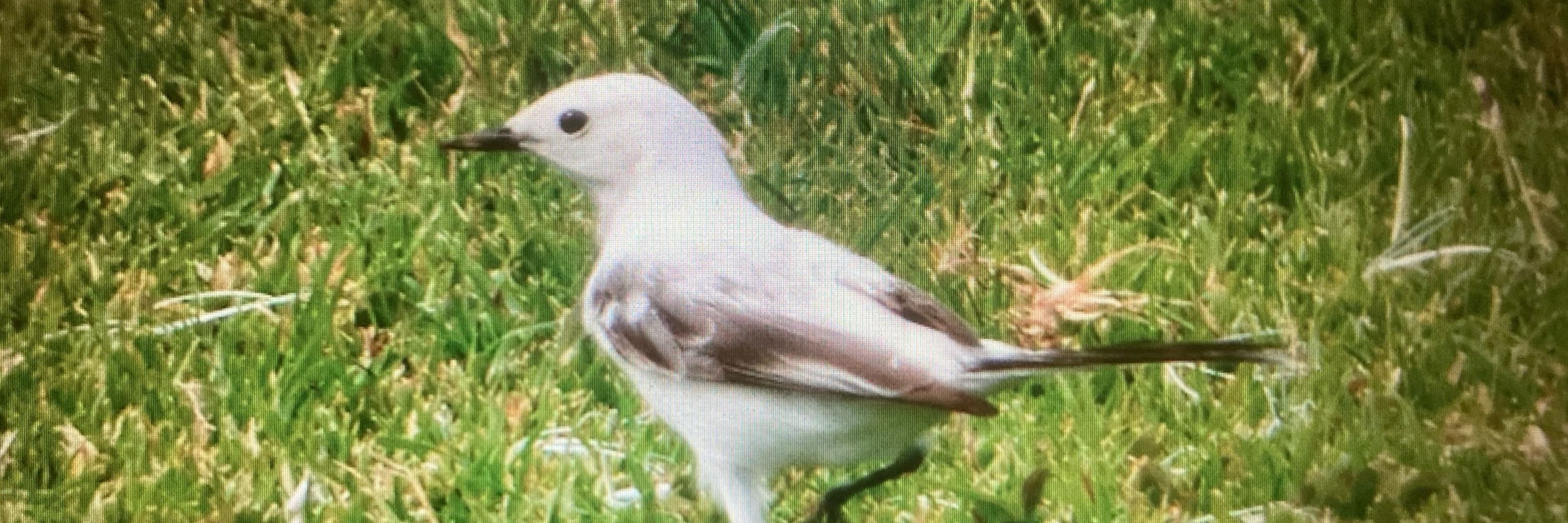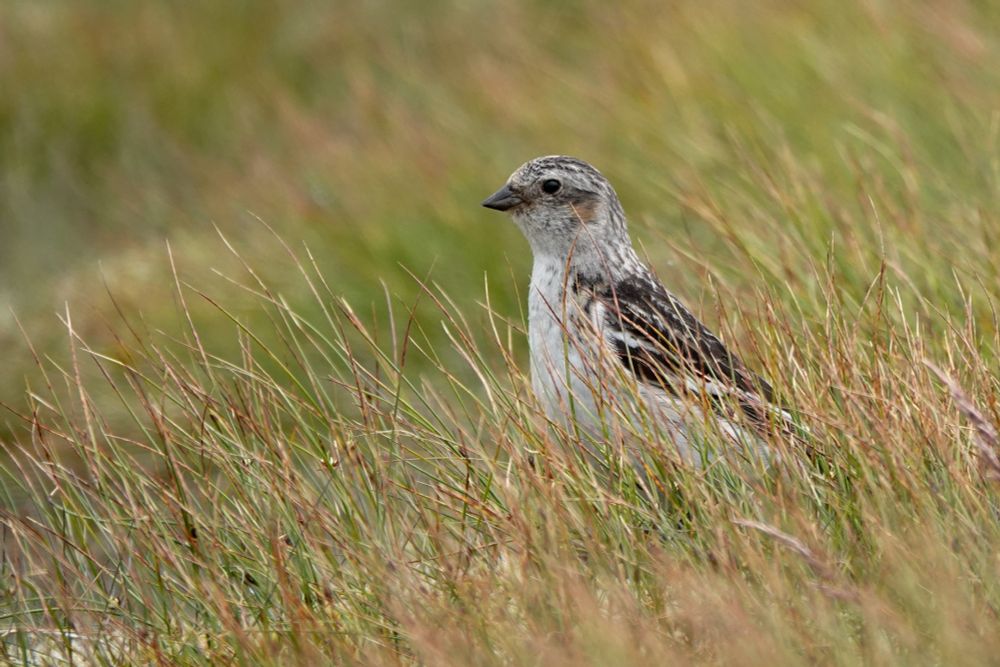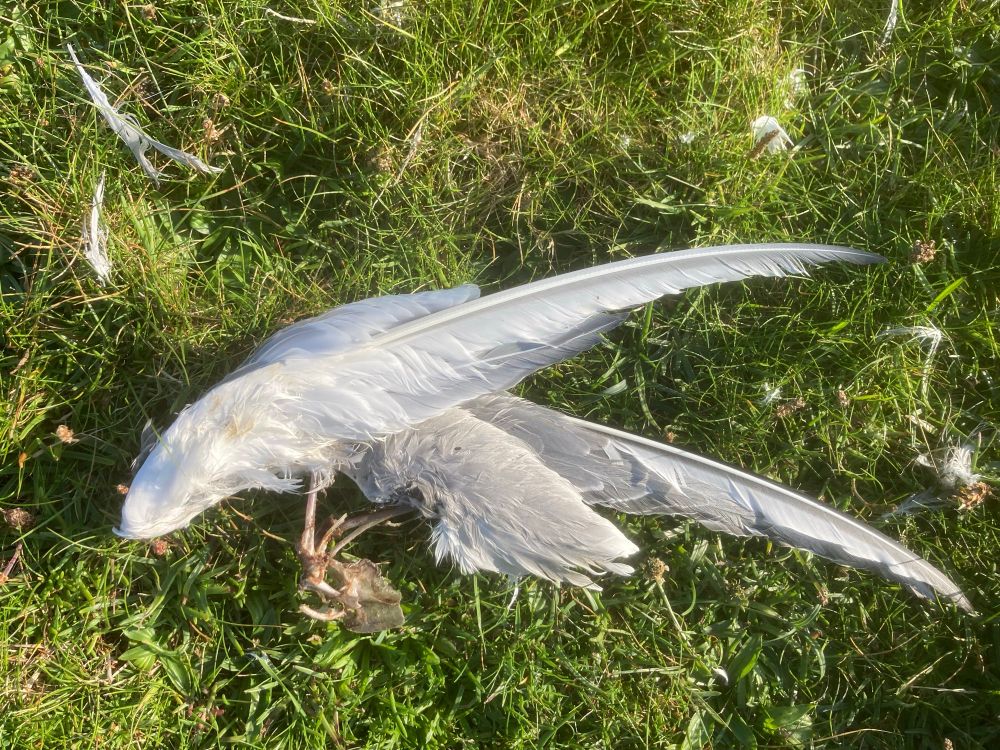
Andrew Harrop
@ahjharrop.bsky.social
For sound recordings go to https://xeno-canto.org/contributor/HNYFHZLJOD
Reposted by Andrew Harrop
Today I collected an audio recorder I left in the Fens with the aim of getting some nice Wigeon recordings. Incredibly it also picked up this Richard's Pipit flying through on the morning of 6th November! xeno-canto.org/1053297 #UKBirding

XC1053297 Richard's Pipit (Anthus richardi)
12 flight calls
xeno-canto.org
November 8, 2025 at 10:47 PM
Today I collected an audio recorder I left in the Fens with the aim of getting some nice Wigeon recordings. Incredibly it also picked up this Richard's Pipit flying through on the morning of 6th November! xeno-canto.org/1053297 #UKBirding
Where are they now? More than 10 years on from the initial revelation, it still blows my mind that Shetland’s phalaropes winter in the Pacific (map from Brooke’s ‘Far From Land’). Yet they are short-distance migrants compared with Arctic Terns… #BirdingScotland

November 7, 2025 at 8:29 AM
Where are they now? More than 10 years on from the initial revelation, it still blows my mind that Shetland’s phalaropes winter in the Pacific (map from Brooke’s ‘Far From Land’). Yet they are short-distance migrants compared with Arctic Terns… #BirdingScotland
Reposted by Andrew Harrop
🚨Hot off the press!🚨A very interesting thread here, and follow the link to the summary of the report. Top work from @ukrbbp.bsky.social
The latest report from the RBBP, Rare Breeding Birds in the UK in 2023, is out now in British Birds. It reports on the 104 species and races of rare breeding birds recording breeding, or showing signs of breeding, in 2023. Read the summary at rbbp.org.uk/2023-report-... #ornithology #ukbirds 🧵[1/15]

November 4, 2025 at 10:59 AM
🚨Hot off the press!🚨A very interesting thread here, and follow the link to the summary of the report. Top work from @ukrbbp.bsky.social
Reposted by Andrew Harrop
Interesting(!) that these captive-bred ducks for sale in East Yorkshire seem to be unringed in very many cases. Baikal, Blue-winged, Green-winged Teals, plus Garganeys. Dread to think how many end up in the wild and in local bird reports... #ukbirding


October 29, 2025 at 12:01 AM
Interesting(!) that these captive-bred ducks for sale in East Yorkshire seem to be unringed in very many cases. Baikal, Blue-winged, Green-winged Teals, plus Garganeys. Dread to think how many end up in the wild and in local bird reports... #ukbirding
Reposted by Andrew Harrop
Over 30 years decline of an iconic farmland bird, Red-backed Shrike Lanius collurio, in a Central European stronghold: meadow loss and shrub succession drive near-local extinction | doi.org/10.1017/S095... | Bird Conservation International | #ornithology 🪶

October 13, 2025 at 3:31 PM
Over 30 years decline of an iconic farmland bird, Red-backed Shrike Lanius collurio, in a Central European stronghold: meadow loss and shrub succession drive near-local extinction | doi.org/10.1017/S095... | Bird Conservation International | #ornithology 🪶
Reposted by Andrew Harrop
Short news piece on the Challenger expedition and the Band-rumped fiesta: britishbirds.co.uk/news/band-ru...
#RareBirdsUK
#RareBirdsUK

Band-rumped Storm-petrels in UK waters | British Birds
The taxonomy and identification of the Band-rumped Storm-petrel Hydrobates castro/monteiroi/jabejabe complex is very, well, complex, as are their previous occurrences in Britain.
britishbirds.co.uk
October 13, 2025 at 6:28 PM
Short news piece on the Challenger expedition and the Band-rumped fiesta: britishbirds.co.uk/news/band-ru...
#RareBirdsUK
#RareBirdsUK
Reposted by Andrew Harrop
6/ Although some native species can also become superabundant & damaging (but only when triggered by disturbance), non-native species are far more likely to be implicated as a cause of global extinction:
t.co/9NUoV81a54
t.co/9NUoV81a54

October 11, 2025 at 7:49 AM
6/ Although some native species can also become superabundant & damaging (but only when triggered by disturbance), non-native species are far more likely to be implicated as a cause of global extinction:
t.co/9NUoV81a54
t.co/9NUoV81a54
Reposted by Andrew Harrop
Now online in Journal of #Ornithology
Three decades of breeding bird population changes in a pristine Danish forest: climate-driven shifts and biodiversity loss compared to national trends
Open access
link.springer.com/article/10.1...
Three decades of breeding bird population changes in a pristine Danish forest: climate-driven shifts and biodiversity loss compared to national trends
Open access
link.springer.com/article/10.1...

Three decades of breeding bird population changes in a pristine Danish forest: climate-driven shifts and biodiversity loss compared to national trends - Journal of Ornithology
Climatic changes are causing general ecosystem changes and species-specific range shifts. To increase our understanding of climate change effects on avian trends and range shifts, this study investigates long-term breeding bird population trends in the pristine Høstemark Forest, Denmark, from 1991 to 2024, in the context of climate change and biodiversity loss. Using territory mapping data from unmanaged pristine forest and national point count data, we examined whether climate-group classifications (leading-edge, neutral, trailing-edge) predict population trends and how a high-quality habitat buffers against climate-driven shifts. Results show significant declines in total bird territories since 1991, while forest-specific bird species abundance remained stable in the Høstemark Forest. Trailing-edge species declined both locally and nationally, while leading-edge species increased locally but not significantly at the national level. Climate-neutral species exhibited local declines despite stable national trends. Species turnover rate appeared to occur more rapidly in the Høstemark Forest compared to the national scale, with both losses of trailing-edge species and gains in leading-edge species. However, despite its ecological quality and stability, the Høstemark Forest experienced a decline in overall bird abundance, suggesting that even pristine habitats can be vulnerable to biodiversity loss, potentially driven by climate change, isolation, and edge effects.
link.springer.com
October 10, 2025 at 9:44 AM
Now online in Journal of #Ornithology
Three decades of breeding bird population changes in a pristine Danish forest: climate-driven shifts and biodiversity loss compared to national trends
Open access
link.springer.com/article/10.1...
Three decades of breeding bird population changes in a pristine Danish forest: climate-driven shifts and biodiversity loss compared to national trends
Open access
link.springer.com/article/10.1...
It occurred to me that I couldn't think of (m)any photos of Short-toed Larks with other species in the frame for size comparison. So here's one of the recent Yell bird (right) with a Meadow Pipit. #BirdingScotland

October 7, 2025 at 3:23 PM
It occurred to me that I couldn't think of (m)any photos of Short-toed Larks with other species in the frame for size comparison. So here's one of the recent Yell bird (right) with a Meadow Pipit. #BirdingScotland
Reposted by Andrew Harrop
I had missed this well written rebuttal on the purported Ivory-billed Woodpecker rediscoveries; these passages in particular are gold:🪶
academic.oup.com/bioscience/a... #Ornithology
academic.oup.com/bioscience/a... #Ornithology


October 3, 2025 at 6:52 AM
I had missed this well written rebuttal on the purported Ivory-billed Woodpecker rediscoveries; these passages in particular are gold:🪶
academic.oup.com/bioscience/a... #Ornithology
academic.oup.com/bioscience/a... #Ornithology
Reposted by Andrew Harrop
Just published: Conservation genomics of two
endangered buntings reveal genetic diversity
before and after severe population declines. doi.org/10.1186/s129... Despite severe population declines, both species retained high genetic diversity but experienced increased inbreeding. #ornithology #birds
endangered buntings reveal genetic diversity
before and after severe population declines. doi.org/10.1186/s129... Despite severe population declines, both species retained high genetic diversity but experienced increased inbreeding. #ornithology #birds

October 1, 2025 at 7:50 PM
Just published: Conservation genomics of two
endangered buntings reveal genetic diversity
before and after severe population declines. doi.org/10.1186/s129... Despite severe population declines, both species retained high genetic diversity but experienced increased inbreeding. #ornithology #birds
endangered buntings reveal genetic diversity
before and after severe population declines. doi.org/10.1186/s129... Despite severe population declines, both species retained high genetic diversity but experienced increased inbreeding. #ornithology #birds
Late September has brought the usual heady mix of brief rarities, misidentifications, and some scarce migrants. Numbers of many 'common' migrants have been low, the only real exceptions to date being Sky Lark and Meadow Pipit. #BirdingScotland

September 30, 2025 at 4:46 PM
Late September has brought the usual heady mix of brief rarities, misidentifications, and some scarce migrants. Numbers of many 'common' migrants have been low, the only real exceptions to date being Sky Lark and Meadow Pipit. #BirdingScotland
Reposted by Andrew Harrop
open.spotify.com/episode/1dlD...
Uncovering the migration patterns of Tengmalm’s Owl in Northern Sweden.
Wild Bird Acoustics brings you the penultimate episode of season 2.
Now Live!
Uncovering the migration patterns of Tengmalm’s Owl in Northern Sweden.
Wild Bird Acoustics brings you the penultimate episode of season 2.
Now Live!

The Long Black Veil; Uncovering the Secret World of Tengmalm's Owl
open.spotify.com
September 16, 2025 at 4:24 AM
open.spotify.com/episode/1dlD...
Uncovering the migration patterns of Tengmalm’s Owl in Northern Sweden.
Wild Bird Acoustics brings you the penultimate episode of season 2.
Now Live!
Uncovering the migration patterns of Tengmalm’s Owl in Northern Sweden.
Wild Bird Acoustics brings you the penultimate episode of season 2.
Now Live!
Reposted by Andrew Harrop
Gosh. That Nathusius' Pipistrelle #bat spike just got a heck of a lot spikier! Not seen anything like this in several years of recording.
@nesmammals.bsky.social @batconservation.bsky.social @mammalsociety.bsky.social
@nesmammals.bsky.social @batconservation.bsky.social @mammalsociety.bsky.social

September 13, 2025 at 11:26 AM
Gosh. That Nathusius' Pipistrelle #bat spike just got a heck of a lot spikier! Not seen anything like this in several years of recording.
@nesmammals.bsky.social @batconservation.bsky.social @mammalsociety.bsky.social
@nesmammals.bsky.social @batconservation.bsky.social @mammalsociety.bsky.social
The last two days have brought a surge of migrants through south Mainland, Shetland. Personal highlights have included 124 Ruffs at Spiggie (the largest number I’ve seen for years), and a healthy scattering of Wrynecks like this one at Quendale. #BirdingScotland

September 10, 2025 at 6:24 AM
The last two days have brought a surge of migrants through south Mainland, Shetland. Personal highlights have included 124 Ruffs at Spiggie (the largest number I’ve seen for years), and a healthy scattering of Wrynecks like this one at Quendale. #BirdingScotland
Reposted by Andrew Harrop
Reposted by Andrew Harrop
Nice to see this white morph Gyr Falcon on North Ronaldsay today. But it seemed to be bearing a ring on its leg. Still nice to see and hopefully a wild one will turn up one day…
#BirdingScotland
#OrkneyBirding
#BirdingScotland
#OrkneyBirding



September 2, 2025 at 5:20 PM
Nice to see this white morph Gyr Falcon on North Ronaldsay today. But it seemed to be bearing a ring on its leg. Still nice to see and hopefully a wild one will turn up one day…
#BirdingScotland
#OrkneyBirding
#BirdingScotland
#OrkneyBirding
Reposted by Andrew Harrop
A sweeping new analysis of birdsong recordings from around the globe shows that light pollution is causing birds worldwide to start singing earlier and keep singing later. #ornithology www.npr.org/2025/08/21/n...

Artificial light has essentially lengthened birds' day
Millions of audio recordings of hundreds of bird species have revealed that artificial light is making the birds wake up earlier and go to bed later.
www.npr.org
August 25, 2025 at 6:56 PM
A sweeping new analysis of birdsong recordings from around the globe shows that light pollution is causing birds worldwide to start singing earlier and keep singing later. #ornithology www.npr.org/2025/08/21/n...
A nice comparison between Black-throated (left) and Red-throated Divers at Quendale this morning. Black-throated has been regular in August at this site in recent years. #BirdingScotland

August 20, 2025 at 1:20 PM
A nice comparison between Black-throated (left) and Red-throated Divers at Quendale this morning. Black-throated has been regular in August at this site in recent years. #BirdingScotland
Reposted by Andrew Harrop
Living the dream working on the Cairngorm Plateau as part of the 2025 Montane Bird Survey. It was also very saddening - walking for days over swathes of beautiful habitat to find no Dotterel where there were once many... #BirdingScotland




July 28, 2025 at 7:16 PM
Living the dream working on the Cairngorm Plateau as part of the 2025 Montane Bird Survey. It was also very saddening - walking for days over swathes of beautiful habitat to find no Dotterel where there were once many... #BirdingScotland
July has mainly been about waders, but by far my most important discovery has been a breeding pair of Red-backed Shrikes in south Mainland (Shetland) which have now fledged young. You can listen to a recording here: xeno-canto.org/1019697 and others will follow in due course.

July 28, 2025 at 5:04 AM
July has mainly been about waders, but by far my most important discovery has been a breeding pair of Red-backed Shrikes in south Mainland (Shetland) which have now fledged young. You can listen to a recording here: xeno-canto.org/1019697 and others will follow in due course.
This white Starling which has been around Spiggie recently appears to be a true albino (most ‘white’ birds are leucistic). Albinos have poor eyesight, so it will be interesting to see how long it survives. #BirdingScotland #ornithology

July 18, 2025 at 2:39 PM
This white Starling which has been around Spiggie recently appears to be a true albino (most ‘white’ birds are leucistic). Albinos have poor eyesight, so it will be interesting to see how long it survives. #BirdingScotland #ornithology
Reposted by Andrew Harrop
open.spotify.com/episode/4hMi...
Wild Bird Acoustics
Season 2; Ep. 15
Now Live!
Another identification feature here, Buntings by sound, for anyone interested in diurnal migration. Delighted to finally release this, complimented by some wonderful Spring audio for listeners….
Wild Bird Acoustics
Season 2; Ep. 15
Now Live!
Another identification feature here, Buntings by sound, for anyone interested in diurnal migration. Delighted to finally release this, complimented by some wonderful Spring audio for listeners….

The Fruits of 2024; The Sound Identification of migrating Buntings
Wild Bird Acoustics · Episode
open.spotify.com
July 16, 2025 at 8:47 AM
open.spotify.com/episode/4hMi...
Wild Bird Acoustics
Season 2; Ep. 15
Now Live!
Another identification feature here, Buntings by sound, for anyone interested in diurnal migration. Delighted to finally release this, complimented by some wonderful Spring audio for listeners….
Wild Bird Acoustics
Season 2; Ep. 15
Now Live!
Another identification feature here, Buntings by sound, for anyone interested in diurnal migration. Delighted to finally release this, complimented by some wonderful Spring audio for listeners….
The beginning and the end for two Arctic Terns at Scatness yesterday evening. The adult may have become prey for a Peregrine; if so it was unlucky, given how few Peregrines are in Shetland. #BirdingScotland


July 14, 2025 at 5:34 AM
The beginning and the end for two Arctic Terns at Scatness yesterday evening. The adult may have become prey for a Peregrine; if so it was unlucky, given how few Peregrines are in Shetland. #BirdingScotland


